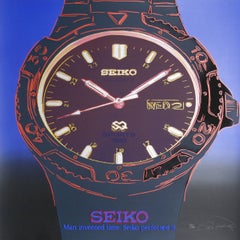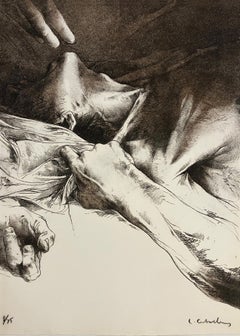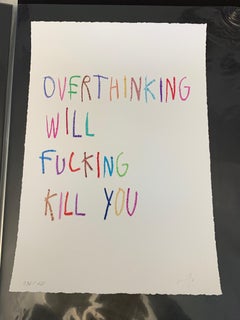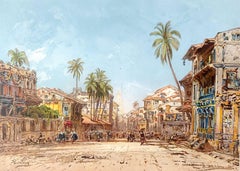Board More Prints
to
5
2
4
3
3
1
Overall Width
to
Overall Height
to
4
4
2
2
2
1
1
1
9
4
2
2
3
6
4
3
11,009
2,937
2,028
1,191
1,163
2
3
8
4
Medium: Board
“Andy Warhol Tate Gallery Exhibition Poster 1971”
By Andy Warhol
Located in Southampton, NY
This is a vintage exhibition poster for an Andy Warhol exhibition held at The Tate Gallery in London from February 17 to March 28, 1971. The poster features Andy Warhol's iconic ima...
Category
1970s Pop Art Board More Prints
Materials
Archival Paper, Lithograph, Board
$595 Sale Price
20% Off
From Primrose Hill, Limited Edition Cityscape Print, Contemporary London Art
Located in Deddington, GB
Jayson Lilley
Please note that insitu images are purely an indication of how a piece may look.
From Primrose Hill is a limited edition hand pulled screen print with gold leaf & ink printed on archival board by Jayson Lilley.
Contemporary artist, Jayson Lilley, is available at Wychwood Art. Jayson Lilley has worked at the forefront of printmaking for many years. His approach to the modern landscape isunique and fresh, in both technique and materials. Lilley’s work is knownfor its urban and architectural focus, zooming in on familiar landmarks andreproducing iconic vistas and structures from the metropolis. Hisinnovative printmaking practice combines silkscreen, painting and collagetechniques to construct vibrant scenes that are always accompanied byexpansive skies and which play on salience and colour.Lilley’s most recentcollection explores some of London’s more natural vistas, as hecontemplates the relationship between nature and the urban landscape. Inthese pieces, he combines silkscreen print with copper leaf and handdrawing to dramatic effect.Lilley graduated from the University for the Creative Arts in 2000 with aFirst Class honours degree in Visual Communication. He had an award-winning career in design before focussing on his artwork, and hisbackground in design is ever apparent in his visual style and methodology.He has exhibited widely across the UK and internationally. Recentaccolades include being shortlisted for the Westmorland Landscape Prize2019 and inclusion in the Royal Academy’s Summer Exhibition 2019. Lilley’s works are held in collections across the world including London,New York, Japan, Hong Kong and Moscow.
From Primrose Hill
Limited Edition Print
Edition of 39...
Category
2010s Contemporary Board More Prints
Materials
Board, Screen
Seiko from Homage to Andy Warhol, Pop Art Screenprint by Rupert Jasen Smith
Located in Long Island City, NY
Artist: Rupert Jasen Smith, American (1953 - 1989)
Title: Seiko from the Homage to Andy Warhol Portfolio
Year: 1989
Medium: Screenprint on Lennox Museum Board with Diamond Dust, sign...
Category
1980s Pop Art Board More Prints
Materials
Board, Screen
Keith Haring - Luna Luna Karussell: A Poetic Extravaganza! Pop Up 3D, 1986
By Keith Haring
Located in Varese, IT
Keith Haring ( 1958 - 1990 ) - Luna Luna Karussell: A Poetic Extravaganza! Pop up 3D, 1986
Additional information:
Material: Color offset print on colored cardboard, shaped and carved, Pop up 3D
Edited in 1986,
Size unfolded: 30.3 x 60.8 x 24 cm
Signature and date printed on the base.
Limited Edition size: 2000
Edition: Luna Luna Freizeitlanlagen GMBH and Neue Revue, Hamburg, Germany
About the work:
“Luna Luna was a project organised by Andre Heller...
Category
20th Century Board More Prints
Materials
Cardboard
Silkscreen: Eight complementary squares w/ four rectangles Geometric Abstraction
Located in New York, NY
Richard Paul Lohse
Group of eight complementary squares with four rectangles (Gruppe von acht komplementären Quadrat Mit vier Rechtecken), 1976
Colo...
Category
1970s Abstract Geometric Board More Prints
Materials
Board, Screen
Untitled II male figurative limited edition print
Located in Miami Beach, FL
Untitled II, by Luis Caballero
Lithography
Size: 15 in H x 10.7 in W
Edition 8/75
Signed in the lower right corner. Numbered in the lower left corner. Great condition with flaws.
...
Category
1980s Board More Prints
Materials
Cardboard, Lithograph
James Crawford "Pile Series" 6 Silkscreen Signed Numbered
Located in Detroit, MI
"Pile Series" was completed during the 1970s. It has a tongue-in-cheek affect as all the prints are photographs of stacks, or "piles", of industrial construction items silkscreened on cardboard giving these building materials a more aesthetic value. These silkscreens are mentioned and one is pictured in the famous, "Kick Out the Jams: Detroit Cass Corridor 1963 - 1977" iconic publication by the Detroit Institute of Arts regarding Detroit's Cass Corridor Artists. They are all signed and numbered.
James Alan Crawford was born in 1944 in Hillsdale, Michigan. He studied art for two years at Michigan State University before transferring to Wayne State University and graduating there. He received his MFA in 1969 while being mentored by John Egner and Aris Koutroulis...
Category
Late 20th Century Contemporary Board More Prints
Materials
Cardboard
Shusaku Arakawa, Japanese-American, A Man Walking, Abstract Silkscreen signed/N
Located in New York, NY
Shusaku Arakawa
A Man Walking, 1968
Silkscreen on velincarton (thin board)
29 4/5 × 21 4/5 inches
Edition of 100
Hand signed and numbered from the edition of 100 on the front
Unframed
Rarely found on the marketplace, another example of this work is in the permanent collection of the Walker Art Center (donated by legendary art dealer Virginia Dwan)
Another rarely seen, richly colored mid century silkscreen...
Category
1960s Abstract Board More Prints
Materials
Screen, Board
Madonna with Child - Tempera on Paper and Cardboard - 1962
Located in Roma, IT
Madonna with Child is an original painting in tempera on paper, applied on the cardboard, realized in 1962 by an Anonymous artist of the XX century, signed with monogram of artist" E...
Category
1960s Board More Prints
Materials
Paper, Tempera, Cardboard
$383 Sale Price
35% Off
Pac-Man from Homage to Andy Warhol, Pop Art Screenprint by Rupert Jasen Smith
Located in Long Island City, NY
Artist: Rupert Jasen Smith, American (1953 - 1989)
Title: Pac-Man from the Homage to Andy Warhol Portfolio
Year: 1989
Medium: Screenprint on Lenn...
Category
1980s Pop Art Board More Prints
Materials
Glitter, Illustration Board, Screen
Still life with hands and apples - XXI Century, Figurative Monotype Print
Located in Warsaw, PL
Siergiej Timochow, a Belorussian artist, born in 1960.
He studied at an art school in Minsk in 1979 before continuing to study at the Fine Arts Academy in Belarus.
His acrylic and ...
Category
Early 2000s Contemporary Board More Prints
Materials
Cardboard, Monotype
Jason Lilley, A little bit of Canary Wharf, London Art, Limited Edition Print
Located in Deddington, GB
Jayson Lilley
A little bit of Canary Wharf
Limited Edition City Scape Print
Hand pulled Screen Print with Gold Leaf, Finished with Pen and Ink on Archival Museum Board
Size: H 24cm x...
Category
21st Century and Contemporary Contemporary Board More Prints
Materials
Ink, Mixed Media, Board, Screen
Superman: Truth, Justice, and the American Way, Lenticular Print by DJ Leon
By DJ Leon
Located in White Plains, NY
'Superman: Truth, Justice, and the American Way' by DJ Leon, 2013. The piece measures 32 x 40 inches. This Lenticular print incorporates, appropriates, and combines images and text f...
Category
2010s Pop Art Board More Prints
Materials
Board, Digital, Lenticular
Related Items
Over Thinking Will Fucking Kill You Screen Print CB HOYO Urban Art Street
By CB Hoyo
Located in Draper, UT
CB Hoyo’s irreverent multidisciplinary practice—which spans painting, sculpture, and installation—approaches art-world fraud, forgery, and hype with a sense of humor. The self-taught...
Category
2010s Pop Art Board More Prints
Materials
Screen
$2,000 Sale Price
20% Off
H 16.5 in W 11.35 in
Shepard Fairey Obey Giant Pyramid Top Icon Face Letter Press Screen Print Street
Located in Draper, UT
Silkscreen on White Cotton Fine Art paper with Silver Metallic Inks
20 × 16 in
50.8 × 40.6 cm
Edition of 19/50
3 colors with deckled edges
Published by Subliminal Projects.
A port...
Category
2010s Pop Art Board More Prints
Materials
Silver
France World Cup Lithograph by Aldo Luongo c.1998
By Aldo Luongo
Located in San Francisco, CA
FRANCE World Cup Lithograph by Aldo Luongo c.1998
Limited edition France 98' World Cup - Official License
From a very limited edition of 300.
Pencil signed lower right. Edition 24/300 lower left.
This is a rare, very small edition lithograph for the 1998 Soccer World Cup...
Category
Late 20th Century Impressionist Board More Prints
Materials
Lithograph
Edgar Plans Sketch Book Signed & Numbered with Hand Finished Doodle
By Edgar Plans
Located in Draper, UT
Book with sketch
11 × 8 in
27.9 × 20.3 cm
Edition 547/1000
Category
2010s Pop Art Board More Prints
Materials
Archival Paper, Carbon Pencil, Color Pencil
$1,500
H 11 in W 8 in D 2 in
Starry Night - Limited Edition, Figurative, Contemporary, Star, Night, Child
Located in Knowle Lane, Cranleigh
Starry Night is a lithograph based on a watercolour by Charlie Mackesy. The edition is limited to 150 and each piece has been signed by Charlie Mackesy...
Category
2010s Other Art Style Board More Prints
Materials
Lithograph
$3,355
H 11.82 in W 7.88 in D 0.4 in
SIGNED Frank Stella poster 1980 Democratic Convention colorful vintage Pop
By Frank Stella
Located in New York, NY
Colorful vintage poster for the 1980 Democratic National Convention, held in Madison Square Garden in New York.Concentric lines of orange and bright green interweave with strokes of ...
Category
1980s Pop Art Board More Prints
Materials
Lithograph
Lines & Color, Straight, Not-Straight and Broken Lines, Using All Combinations..
By Sol LeWitt
Located in Milford, NH
A colorful geometric silkscreen print by American artist Sol LeWitt (1928-2007). LeWitt was born in Hartford, Connecticut, and attended Syracuse University where he studied tradition...
Category
1970s Abstract Geometric Board More Prints
Materials
Paper, Screen
$1,950
H 32.88 in W 32.88 in D 1.5 in
Untitled, from the Kinderstern Portfolio
By Sol LeWitt
Located in Milford, NH
A fine black and white silkscreen geometric print from the Kinderstern Portfolio by American artist Sol LeWitt (1928-2007). LeWitt was was born in Hartford, Connecticut, and attended...
Category
1980s Abstract Geometric Board More Prints
Materials
Paper, Screen
Chama Canyon hand pulled serigraph by William Hook
By William Hook
Located in Paonia, CO
Chama Canyon is a limited edition hand-pulled serigraph no. 225 /260 in excellent condition. It is signed in pencil and published by Aspen Mountain Graphics. sheet size 14 x 18 image 12 x 16
For American artist William Hook ( b. 1948- ) art was a central focus in his family home and he began his career in art at an early age.. He studied at several prestigious art schools in the US and abroad. His work has been featured in magazines such as Southwest Art, Art of the West, U. S. Art, American Artist and Focus Santa Fe. The book… Leading the West… by Donald Hagerty features William Hook as one of the most notable influences on the western art scene. Publishers Harper-Collins and North Light have included his work in numerous books written about the contemporary art process in Europe and America. Hook’s paintings can be found in the permanent collections of the Denver Art Museum, the Tucson Art Museum, the University of New Mexico, the FORBES Museum, NYC, and the Genesee Museum, NY as well as in many corporate and private collections. His work has also been featured in prints for the New Mexico Symphony, Music from Angel Fire...
Category
20th Century Expressionist Board More Prints
Materials
Screen
Vintage Frank Stella poster Democratic Convention 1980 colorful Pop political
By Frank Stella
Located in New York, NY
Colorful vintage poster for the 1980 Democratic National Convention, held in Madison Square Garden in New York.Concentric lines of orange and bright green interweave with strokes of pink, yellow, red, turquoise, silver, and gold. Printed with metallic ink that catches light differently from each angle, complementing the poster’s lime green and red text. The top of the poster reads “Let us move forward with a strong and active faith.”
It was at this 1980 convention that Jimmy Carter was nominated for reelection. This large poster was printed by Petersburg Press in 1980, and features Frank Stella’s Polar...
Category
1980s Pop Art Board More Prints
Materials
Lithograph
LOVE /// Robert Indiana Typography Pop Art Screenprint Black and White Print Art
Located in Saint Augustine, FL
Artist: (after) Robert Indiana (American, 1928-2018)
Title: "LOVE"
Portfolio: Banner, Multiples Calendar for 1970
*Issued unsigned
Year: 1969
Medium: Original Screenprint on smooth w...
Category
1960s Pop Art Board More Prints
Materials
Screen
Sangre de Christos hand-pulled serigraph by Robert Daughters
Located in Paonia, CO
Sangre de Christos is a hand-pulled, limited edition serigraph, no. 39 / 260 and is signed in pencil by the artist. Published by Aspen Mountain Graphic...
Category
20th Century Expressionist Board More Prints
Materials
Screen
Previously Available Items
India Bombay Street Scene 19th Century Chromolithograph Makers Mark Stamp
By Eduard Hildebrandt
Located in Norfolk, GB
Eduard Hildebrandt
19th Century Chromolithograph on thick paper
Strasse in Bombay, c 1865
Signed and titled lower edge, makers stamp back
Sheet size 45.5cm x 55.5cm, Image size 24.2...
Category
1870s Impressionist Board More Prints
Materials
Board, Lithograph
Mario Schifano - Monochrome - Hand Signed Serigraphy, 1975
Located in Varese, IT
Mario Schifano ( 1934 - 1998 ) - Monochrome - Hand Signed Serigraphy With Enamels On Cardboard, 1975
Additioonal Information:
Material:Materic serigraphy with enamels on cardboard
V...
Category
20th Century Board More Prints
Materials
Enamel
Mario Schifano - Monochrome - Hand Signed Serigraphy, 1975
Located in Varese, IT
Mario Schifano ( 1934 - 1998 ) - Monochrome - Hand Signed Serigraphy With Enamels On Cardboard, 1975
Additional Information:
Mario Schifano ( 1934, 1998 )
Material: materic serigrap...
Category
20th Century Board More Prints
Materials
Enamel
Mario Schifano - Monochrome - Hand Signed Serigraphy, 1975
Located in Varese, IT
Mario Schifano ( 1934 - 1998 ) - Monochrome - Hand Signed Serigraphy With Enamels On Cardboard, 1975
Additional Information:
Mario Schifano ( 1934, 1998 )
Material: materic serigrap...
Category
20th Century Board More Prints
Materials
Enamel
Mario Schifano - Monochrome - Hand Signed Serigraphy, 1975
Located in Varese, IT
Mario Schifano ( 1934 - 1998 ) - Monochrome - Hand Signed Serigraphy With Enamels On Cardboard, 1975
Additional Information:
Mario Schifano ( 1934, 1998 )
Material: materic serigrap...
Category
20th Century Board More Prints
Materials
Enamel
Mario Schifano - Monochrome - Hand Signed Serigraphy, 1975
Located in Varese, IT
Mario Schifano ( 1934 - 1998 ) - Monochrome - Hand Signed Serigraphy With Enamels On Cardboard, 1975
Additional Information:
Mario Schifano ( 1934, 1998 )
Material: materic serigrap...
Category
20th Century Board More Prints
Materials
Enamel
Mario Schifano - Monochrome - Hand Signed Serigraphy, 1975
Located in Varese, IT
Mario Schifano ( 1934 - 1998 ) - Monochrome - Hand Signed Serigraphy With Enamels On Cardboard, 1975
Additional Information:
Mario Schifano ( 1934, 1998 )
Material: materic serigrap...
Category
20th Century Board More Prints
Materials
Enamel
Mario Schifano - Monochrome - Hand Signed Serigraphy, 1975
Located in Varese, IT
Mario Schifano ( 1934 - 1998 ) - Monochrome - Hand Signed Serigraphy With Enamels On Cardboard, 1975
Additional Information:
Mario Schifano ( 1934, 1998 )
Material: materic serigrap...
Category
20th Century Board More Prints
Materials
Enamel
Mario Schifano - Monochrome - Hand Signed Serigraphy, 1975
Located in Varese, IT
Mario Schifano ( 1934 - 1998 ) - Monochrome - Hand Signed Serigraphy With Enamels On Cardboard, 1975
Additional Information:
Mario Schifano ( 1934, 1998 )
Material: materic serigrap...
Category
20th Century Board More Prints
Materials
Enamel
Mimmo Paladino - Complete Folder Containing 8 Mixed Media Works - Rabanus Maurus
Located in Varese, IT
Mimmo Paladino (1948) - complete folder containing 8 mixed media works - RABANUS MAURUS - De Universo
Additional information:
RABANUS MAURUS - De Universo
Material: Each one are big...
Category
21st Century and Contemporary Board More Prints
Materials
Gold Leaf
Happy Daze / Landscape and Nature / Smile / Framed and Unique Mixed Media Art
Located in Greenwich, CT
"Happy Daze"
35.5 x 35.5 inches
Glitter on 320gsm cotton rag archival paper, mounted on archival mount board
Happy Days depicts a wooded landscape with a deer and her fawn taking refreshment in the shallows of a lake. Over the vista, a smiley face is superimposed in varnish, gently laced with a rainbow foil, 'Paint by Numbers' pattern. Bright and poppy, the print subverts the picture postcard, both offering and withholding a tantalising space within.
Benjamin Thomas Taylor...
Category
21st Century and Contemporary Contemporary Board More Prints
Materials
Glitter, Mixed Media, Board, Archival Paper
Jack in the Box Gene Davis color field 1960s multicolor abstract stripe print
By Gene Davis
Located in New York, NY
Vertical stripes, the artist’s trademark, run perfectly even and parallel down the sheet in ultramarine, light blue, black, purple, lime green, yellow, orange, pink, and periwinkle. ...
Category
1960s Color-Field Board More Prints
Materials
Canvas, Board, Screen
H 30 in W 20 in D 0.18 in
Board more prints for sale on 1stDibs.
Find a wide variety of authentic Board more prints available on 1stDibs. While artists have worked in this medium across a range of time periods, art made with this material during the 21st Century is especially popular. If you’re looking to add more prints created with this material to introduce a provocative pop of color and texture to an otherwise neutral space in your home, the works available on 1stDibs include elements of blue, pink, purple and other colors. There are many well-known artists whose body of work includes ceramic sculptures. Popular artists on 1stDibs associated with pieces like this include Rupert Jasen Smith, Jayson Lilley, Courty, and Gene Davis. Frequently made by artists working in the Contemporary, Pop Art, all of these pieces for sale are unique and many will draw the attention of guests in your home. Not every interior allows for large Board more prints, so small editions measuring 0.04 inches across are also available Prices for more prints made by famous or emerging artists can differ depending on medium, time period and other attributes. On 1stDibs, the price for these items starts at $44 and tops out at $225,000, while the average work can sell for $956.
Recently Viewed
View AllMore Ways To Browse
Delta Poster
Ed Ruscha Sin With Olive
Ed Ruscha Sin
Ewan David Eason
Florida Vintage Travel Posters
Goodyear Poster
Gustav Klutsis
Ihap Hulusi
Ivan Navarro
James B Painter
James Bond Movie Posters
Jan V Roy Posters
John Lennon On Sale
Lait Pur Sterilize
Lake District Vintage Travel Poster
Land Rover Poster
Le Frou Frou Vintage Poster
Leon De Pas








